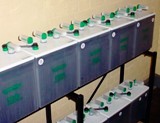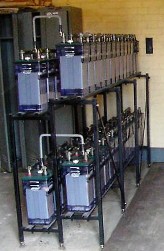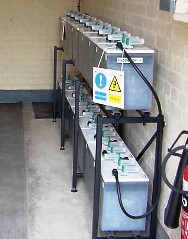Lead-acid battery malfunctions and how to fix them
1. Increased self-discharge manifests itself in loss of capacity.
 Normal self-discharge is the result of galvanic processes in the battery due to the presence of impurities in the electrode material and in the electrolyte and usually does not exceed 0.7% of the capacity per day. Increased self-discharge in portable batteries is due to leakage of current on the outer surface of lids and containers wet with electrolyte during careless filling or during gas release. Self-discharge for this reason, especially if the surface is also contaminated with dust, can be so great that the battery is completely discharged within 10-20 days.
Normal self-discharge is the result of galvanic processes in the battery due to the presence of impurities in the electrode material and in the electrolyte and usually does not exceed 0.7% of the capacity per day. Increased self-discharge in portable batteries is due to leakage of current on the outer surface of lids and containers wet with electrolyte during careless filling or during gas release. Self-discharge for this reason, especially if the surface is also contaminated with dust, can be so great that the battery is completely discharged within 10-20 days.
To eliminate self-discharge, it is necessary to clean the surface with a rag moistened with distilled water, then neutralize it with an alkaline 10% solution of soda ash or ammonia (ammonia water): moisten the rag with a solution and thoroughly wipe the surface of the lids and the dishes. In this case, you must carefully monitor that the alkaline solution does not fall into the battery and contaminate the electrolyte.After neutralization, the dishes are again wiped with a damp cloth and then wiped dry.
If, after wiping the surface, the self-discharge has not decreased, it is necessary to analyze the electrolyte from the battery, and if harmful impurities are found in quantities exceeding the permissible, to discharge the battery and replace the electrolyte. After pouring the electrolyte, each cell is poured with distilled water and allowed to stand for 1 hour. The water is then poured out, the cell is again poured with water, and a weak current passes through the battery for 2 hours — about 1/10 of the normal. After that, the water is poured out, the battery is rinsed with distilled water, filled with an electrolyte of normal density and charged with a normal charge with a current of 0.1 C20.
Electrolyte contamination. A decrease in capacity and increased self-discharge of batteries often occurs due to the presence of impurities in the water that is added to the batteries or in the acid used to prepare the electrolyte. Often, contaminants enter the battery when the repair technology is violated, for example, when soldering jumpers with POS solder, during prolonged contact of bare copper wires with battery covers moistened with electrolyte, etc.
The presence of some harmful impurities can be determined by external signs:
- chlorine - the smell of chlorine near the elements and the deposition of a light gray sediment at the bottom of the vessel;
- copper — noticeable gas release at rest and constant charging;
- manganese — during charging, the electrolyte acquires a light red color;
- Iron and nitrogen are not detectable by external signs and can only be detected by chemical analysis.
In all cases of detection of unacceptable impurities in the electrolyte, it must be replaced. To do this, discharge the battery, pour out the electrolyte, fill it with distilled water checked for the absence of chlorine and put it for 1 hour to charge with a weak current of 0.05 C10. Then drain the water, fill with high quality electrolyte and charge with normal charging current.
Cell retardation is characterized by low voltage, as well as a lower density of the electrolyte of individual cells compared to others, and usually arises from insufficient recharge voltage, the initial stage of sulphation of the plate, short circuit and the presence of harmful impurities in the electrolyte .If a lag is detected, it is imperative to analyze the electrolyte for the presence of chlorine, iron, copper in it. In non-starting cases, the fault is eliminated by equalizing the charge or by increasing the float voltage.
If lagging is not eliminated by charging the lagging cell from an external source, the lagging cells are cut from the battery and charged until their capacity is restored.
2. Short circuits inside the batteries occur mainly during the destruction of the separators and through the accumulation of spongy lead on the edges of the plates.

Often the cause of a short circuit is a high level of sediment at the bottom of the vessels, which, reaching the lower edge of the electrodes, creates conductive bridges between them.
To eliminate short circuits, it is necessary to discharge the battery with a 10-hour discharge current to the final voltage and disassemble the cell.After removing the short circuit—replacing damaged separators, cutting away the accumulations on the plates with a knife, cleaning the dishes and removing the sediment, washing the plates—the cell is assembled and charged in the formative charge mode.
3. The destruction of the plates is characterized by the disintegration and fall of the active mass and corrosion of the grids.
The characteristic signs of the destruction of the plates are a sharp decrease in the battery capacity, a short discharge time and a rapid increase in the density of the electrolyte to normal during charging. The electrolyte becomes cloudy and brown in color. The reason for the destruction of the plates is system charging, high current charges and temperature rise. Systematic charging with excessively small currents can also cause destruction of the plates. Sulfating the plates also causes their destruction, since lead sulfate has a larger volume than lead peroxide and sponge lead.
Batteries with damaged plates are not suitable for operation and must be replaced.
4. Sulfation of the plates is the most common and dangerous damage to the battery.
As mentioned above, the formation of lead sulfate (lead sulfate) PbSO4 is a normal consequence of battery operation. Lead sulfide generated in the normal mode has a fine crystalline structure. As a result of self-discharge when the battery is inactive, especially at elevated temperature and density of the electrolyte, the PbSO4 crystals are large. Subject to the rules of battery storage, the crystals will still disintegrate under the influence of normal charging.
5.Deep sulphation, as a rule, is the result of improper use of batteries and is caused by the following main reasons:
- insufficient charging voltage and current;
- increased self-discharge due to short circuit in the elements;
- the presence of harmful impurities in the electrolyte;
- excessive concentration and high temperature of the electrolyte;
- systematic undercharging of batteries operating in the "charge-discharge" mode;
- systematic deep discharges;
- frequent charging with high currents;
- long-term leaving a discharged battery without charging;
- a long period of time (more than 6 hours) between filling a new non-dry battery with electrolyte and starting to charge it.
Under the influence of these factors, the lead sulfate on the plates is transformed into a coarse crystal structure and forms a continuous crust of lead sulfate. Intense sulfate formation also occurs when plates moistened with electrolyte come into contact with air due to the exposure of the plates due to the reduced level of electrolyte. Coarse crystalline sulfate no longer decomposes during normal charging and the sulfation is said to be irreversible.
The active mass of positive plates subjected to excessive sulphation acquires a light brown tint with white spots of sulphate. Sometimes the color remains dark, but the presence of coarse crystalline sulphate is indicated by the hard, rough surface. The active mass of the sulfated positive plate rubs between the fingers like sand.
The surface of the negative plates is coated with a continuous layer of lead sulfate. The active material becomes hard, rough, as if it is sandy to the touch. There is no clear metal line on the surface of the plates if you draw a knife on it.
Because coarse crystalline sulfate is a poor conductor of electrical current, when irreversible sulfation occurs, the internal resistance of the cell increases. As a result, the charge voltage rises to 3 V and the discharge voltage drops dramatically. Large crystals clog the pores in the active mass, which makes it difficult for the electrolyte to enter the inner layers. Battery capacity becomes much lower than normal. These signs are typical of sulfate batteries.
6. Excessive sludge production.
When the electrolyte is contaminated with iron and nitric acid and its salts, as well as during a short circuit and improper operation (severe overloads and deep discharges), particles of the active mass fall from the plates, forming a precipitate (sediment), which, rising to plates, may cause a short circuit.
Characteristic signs and reasons for the appearance of sediment.

In accordance with the reasons that caused the increased separation of sediments, measures should be taken to remove them.
Sediment is removed from open vessels using a pump or siphon by pumping the cloudy electrolyte with a glass rod from cells previously discharged to 50-60% of their capacity. In this case, care must be taken not to cause a short circuit with sediment particles. After evacuation, the elements should be rinsed with distilled water.
Instead of the poured electrolyte, clean is poured into the jars, because you cannot keep bare plates in the air for a long time.
Sediment is removed from portable batteries once a year by disassembling the plates and rinsing the containers and plates of the previously discharged battery.
7. Reverse the battery polarity.
If the battery consists of series-connected cells of different capacities, or some of the cells have cut or sulfated plates, then when the battery is discharged, the cells with lower capacity may be discharged to zero, and the rest will still give a discharge current. This current flowing through the discharged cells from negative to positive begins to charge them in the opposite direction (the negative plate will become positive and the plus plate will become negative). In this case, a mixture of lead dioxide and spongy lead appears in the plates, strong self-discharge occurs and sulphation is formed.
Negative plates darken and swell greatly. Such elements should be cut from the battery and subjected to several training shocks and charge.
Polarity reversal can also occur when the battery is mistakenly connected to the opposite poles (plus to minus, minus to plus) of charging motor generators or rectifiers of old design that do not have protection against incorrect switching. It is necessary to carefully monitor the correct connection of the charging battery. A mistake noticed in time can be corrected. By switching the battery to the correct charging mode, it eliminates the polarity reversal of the electrodes.
If the reversal of the polarity is caused by prolonged incorrect switching on, it is necessary to carry out 2-3 «charge-discharge-charge» cycles. In particularly unfavorable cases, the polarized battery does not recover its capacity and completely disintegrates.
8. Reduced battery insulation resistance will cause self-discharge.
It most often occurs due to contamination of the surface of the batteries, penetration of electrolyte on the lids and outer walls of the vessels and on the racks. If leakage of electrolyte from cracks in the tank is detected, it must be replaced.
Cracks in the sealing mastic are repaired by melting it with a low flame of a gas burner or blow torch.
Attention: work must be done outside the battery compartment. The battery should be discharged, left alone for 1-2 hours with the caps open, then blown with air to remove residual gases and prevent the explosion of the explosive mixture. Melting must be done carefully so that the edges of the tanks and lids do not catch fire.
9. Cracks in ebonite monoblocks and vessels.
Damage to monoblocks and containers causes leakage of electrolyte, contamination of the battery compartment and creates conditions for self-discharge of the battery. In addition, sulfuric acid fumes are harmful to service personnel. Cracks in the intercellular partitions of monoblocks are particularly dangerous for batteries. Electrolytic contact between adjacent cells creates pathways for enhanced self-discharge. With large cracks, the self-discharge current reaches a short-circuit value, the battery voltage is reduced by 4 V, and the electrodes are sulphated or completely destroyed.
Damaged monoblocks of starter batteries are usually impractical to repair, especially in the presence of cracks in the intermediate element partitions. If it is impossible to replace the monoblock with a new one, the repair can be effective when the battery will be used in stationary conditions (not subject to impact and shaking).
The monobloc to be repaired is washed abundantly with running water and dried at room temperature for 3-4 hours. Drying in cabinets at a temperature not higher than 60 ° C is allowed.
To seal through cracks, the latter are drilled at the edges with a drill with a diameter of 3-4 mm. The cracks are cut with a file or chisel to a depth of 3-4 mm. In monoblocks with acid-resistant inserts, drilling and cutting out cracks is carried out only to the depth of the asphalt mixture and only from the outside. The ebonite blocks are cut from both sides. The cut crack is cleaned with sandpaper until a rough surface with a width of 10-15 mm is created on both sides of the crack. After that, the cleaned areas are degreased with a napkin dipped in acetone and dried for 5-6 minutes.
The repaired monoblock must be tested for leaks using a special device.
When checking the monoblocks for damage, special care should be taken and in no case hold the two electrodes in your hands, as this can lead to an electric shock.
Re-soldering and straightening boards
If the plates are strongly distorted (especially positive) as a result of improper operation, electrolyte contamination or short circuit, it is necessary to sort the batteries and straighten the plates. This should be done by discharging the batteries.The negative plates must be immediately immersed in distilled water to remove the acid from them, and only by changing the water two or three times can they be kept in the air. Charged negative plates in the air become very hot and become unusable.
When removing the positive plates, be careful not to touch the negative plates. For alignment, the cut positive plates are placed between two smooth boards and then gradually and carefully weighted. In no case should you hit with a hammer and press sharply on the plates, as they can break due to their fragility.
Soldering the plates in the battery compartment during charging is strictly prohibited! They can be soldered no earlier than two hours after the end of charging and with continuous ventilation.
Soldering the connections of stationary batteries should be done using a hydrogen flame or an electric charcoal heater. This work may only be performed by specially trained personnel.
Soldering of small batteries (starter, filament, etc.) can be done with an ordinary soldering iron, but without the use of tin solders and acid, which contaminate the battery and lead to its self-discharge and damage.
A soldering iron, cleaned of tin, melts a rod or strip of pure lead, which, falling into the seam, welds together the lead parts of the battery. Care must be taken that the molten lead does not create filaments which, if caught in the cell, may cause a short circuit. You need to weld the entire cross-section of the wires and jumpers so that their conductivity does not decrease.
